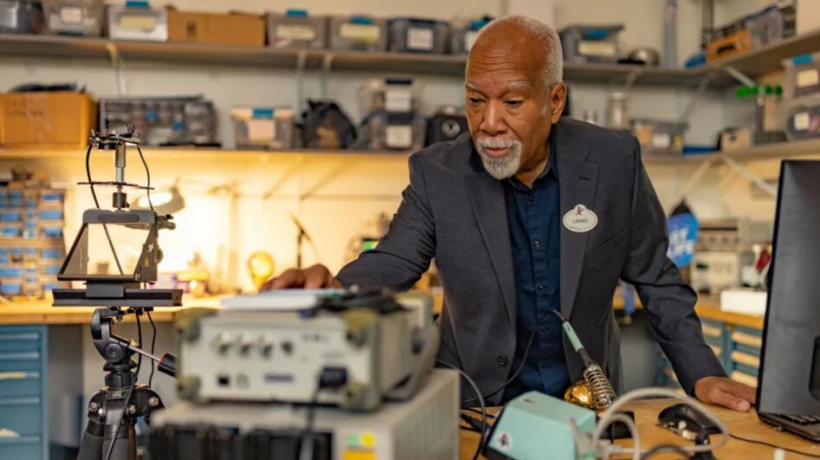Disney Imagineer Lanny Smoot is walking through Disneyland, the theme park where many of his inventions pepper rides and experiences. He’s in a plaza, wandering around like he’s trying to decide which ride to go on next. He heads down one path then turns around and heads in another direction, right towards the castle at the center of the park.
The Disneyland that Smoot is walking through is actually a 3D digital model, and he’s seeing it not in real life but through the screen of a virtual reality headset. And unlike most VR experiences, where Smoot’s meandering stroll and repeated directional changes would have set him on a collision course with a wall or piece of furniture, Smoot is in no danger of walking into anything. Because while he is walking, the floor beneath him is moving like an omnidirectional treadmill. Smoot himself hasn’t moved more than a few square feet in actual physical space.
What he’s standing on is the HoloTile floor, the latest of his inventions for Disney Research and Disney Imagineering. Made up of hundreds of tiny, tile-like disks arranged in a roughly five-foot-wide circle, the floor is a mechanical surface that moves in response to the motion of a person, or multiple people, on top of it. Using Lidar-based sensors, custom software, and rotating disks that move in synchrony, the floor subtly moves underfoot and creates the illusion of walking and covering ground.
“Every part of the floor is capable of moving anything on its surface in any direction. All of the floor is live,” Smoot says. That could be a person on a stroll, as he demonstrated in a video teasing the technology, or an inanimate object being moved on command through remote control. “I think the HoloTile floor is the answer to virtual reality,” he says.
The technology has been in the works for years, and was inspired by science fiction. Smoot, who has more than 100 patents to his name, had previously created an extendable and retractable lightsaber from the Star Wars franchise, but was always more interested in another space-based series. “My company may be angry, but I was a Star Trek kid,” he says. The idea for the moving floor is Smoot’s take on the Holodeck, a virtual reality room that frequently appeared in episodes of Star Trek: the Next Generation. It was a space that allowed users to enter an immersive and limitless simulation of a physical environment. The concept—and its impossibility—intrigued him.
“You certainly can do part of that with virtual reality. That will get you the visuals. But how do you do the physical walking with a finite space?” Smoot says. “We’re not going to build a whole planet for you to walk on if you want to experience something. I started looking at different ways that you could move things on a floor.”
Experimentation eventually led to the HoloTile, which Smoot will only describe in minimal detail. Exactly how the floor moves is being tightly controlled by Disney, but Smoot compares it to “undoing” the movement of a person, as if the ground detects someone walking forward and imperceptibly pushes them backward.
Though omnidirectional treadmill devices are not totally new, the ones that do exist are large and cumbersome, and typically designed for a single user. Smoot says from the start, the HoloTile project aimed to be a multi-person experience. The floor, its sensors, and its software can all detect and react to multiple people at the same time, enabling people to have shared experiences in virtual reality, for example. The technology is able to subtly redirect users in motion if they’re in danger of bumping into each other. The software also accounts for individual users’ gaits. “[It] moves you in a way that’s comfortable for you. Obviously you never want somebody to fall on this floor. That’s not an option for us,” Smoot says. “The software that runs this is absolutely sophisticated to make sure it can keep track of a bunch of folks or a bunch of objects.”
Smoot says the HoloTile floor won’t just be for people, and won’t just be for VR. He and his team at Disney Imagineering have envisioned it for company-specific projects like rides or experiences in Disney theme parks, as well as for stage performances, sports training, and even industrial use cases. “Virtual reality is an obvious one. It’s way not the only one,” he says.
There’s already a hunger for what this device offers in the VR realm. Architects and builders, for example, are already integrating VR tools into the way they design projects and refine buildings before they get constructed. Smoot sees a similar potential within the Disney universe. “We could use it for our designs,” he says. “If the Walt Disney Company wants to build a new attraction, why not walk through it in CAD living on the HoloTile floor before you build it?”
How the company plans to use the technology is still under wraps. The HoloTile was announced publicly in late January in honor of Smoot’s induction into the National Inventors Hall of Fame, offering a rare window into a project that’s still taking shape. “I was very happy the company allowed me to show this because normally we don’t show things in a very early stage,” Smoot says. “The design is pretty stable now. Now it’s up to us to figure out what we want to do with it exactly.”
The possibilities, Smoot says, are huge, and go beyond just making a fun experience at a theme park. “I have worked on lightsabers and all kinds of things, but I have a feeling this one is really important,” he says.







